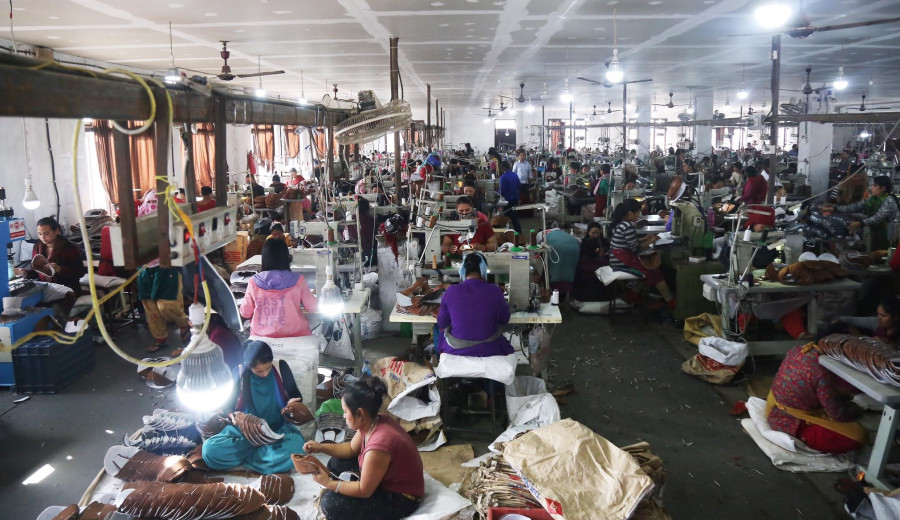Columns
Here’s how to help ‘Ram Bahadur’
The adage that everything from salt to gold comes from outside hardly seems false.
Shuvangi Khadka
A couple of weeks ago, a video interview of businessman Saurabh Jyoti made the rounds across social media. In one of the clips which became ‘viral’, Jyoti talks about how an average Nepali ‘Ram Bahadur’ wakes up to the sound of an alarm clock made in China, pours himself a cereal breakfast from Kellogg’s, wears Levi’s jeans, mounts a bike built in Japan and then heads off to search for a job. Having failed to find a job, Ram Bahadur, according to Jyoti, returns home tired, sits on a Malaysia-made sofa, pours himself a glass of French wine...and wonders why he can’t find himself a well-paying job in Nepal.
Jyoti drew this example to explain how people use foreign brands and products everyday without awareness or a conscious effort to use local products. While an average Nepali may not be financially capable to buy and use branded products like Levi’s or eat expensive cereal like Kellogg’s, we surely make overwhelming use of products from outside everyday—from edibles like fruits and nuts to apparels. This becomes pretty apparent when one just glances at the burgeoning import figures. An old adage that everything from salt to gold in Nepal comes from outside hardly seems false even today.
Netizens were quick to slam the businessman’s statement for its lack of sensitivity and awareness of how an average Nepali actually leads his or her life. Along with Jyoti’s view through his elite glasses, other comments on the video criticised him for being an avid investor in franchises of foreign businesses like Hero Honda, Honda, Philips or Baskin-Robbins and then making remarks about people for not using Nepali products. One may go so far as to ask why he doesn't support local automobiles and invest in them instead of investing in Honda bikes. But as an investor, it is solely his privilege to decide where he puts his money. And it is also the same for consumers.
The truth is that any consumer in an economic sphere behaves rationally. So, when a person chooses a particular product, the decision stems not only from awareness about product origin but from the need to make a rational decision: Is the product cheaper and of better quality compared to its alternatives?
Imported raw materials
Products made in Nepal are usually said to be of inferior quality or expensive. This is true as even if the goods are manufactured or assembled in Nepal, most raw materials have to be sourced from outside. In this regard, people often call for protecting domestic industry through quotas and tariffs on imports or by providing subsidies to local firms. But can we protect all domestic industries? Do we need to protect all domestic industries?
Protectionists usually talk in terms of saving industries to save jobs. However, the facts show that tariffs and quotas seldom save jobs for long or preserve the competitiveness of the industry to be “saved.” New jobs created in the protected sector also means jobs are eliminated in other sectors. Meanwhile, consumers suffer due to higher prices. Protection can be granted to domestic industries in the form of subsidies. But sometimes, the efforts made to save them may not really translate to saving. Take a recent example of the pashmina industry in Nepal. Despite the government's providing direct cash incentives, the industry has been falling behind.
The important thing in trade is capitalising on a country's competitive edge or advantage. In today’s world of globalisation, a country cannot be self-sufficient. Even if products are made within the country, the raw materials still need to be imported. Steel and iron factories in Nepal are said to be fulfilling increasing demand. But 90 percent of their raw materials are imported from India and the remaining 10 percent from other countries. Without the necessary infrastructure and newer technologies, capital intensive industries can hardly operate or survive in Nepal. No matter how much we may want to preach about sustaining ourselves, we know how the blockades imposed by India have severely crippled our economy.
Protection should also not be understood in narrow terms as recently argued in the case of foreign investment in agriculture. Such investments are necessary to increase capacity and utilise untapped potential. For these industries to truly flourish, we need more investment in technologies. Similarly, due to the underproduction of our competitive goods like carpets, pashmina and travel goods, Nepal has not been able to take advantage of facilities provided by other countries. We lag behind in producing goods on a large scale, properly marketing them and enhancing their quality.
Some notable local brands like CG WaiWai, Goldstar, Dulla (The Factory Team) or Himalayan Java have made their mark in the face of competition. Local markets are flooded with products from India and China, but it is the domestic company’s ability to create greater value that matters. Of course, the government needs to ensure there is infrastructure, research for new resources, electricity and basic utilities to create a suitable environment. But the onus ultimately falls on the company’s ability to innovate and develop. For this, industries can find a way to specialise in sectors where we have a competitive edge, making optimum use of available resources and local raw materials.
Competitive advantage
In an ideal world, we could equally uplift all domestic industries and protect every industry. But in a not so ideal world, resources are scarce and they have to be used efficiently. Research in developing countries has shown that instead of trying to increase the international competitiveness of all domestic industries, we have to focus on aiding workers who have been displaced by foreign competition.
Ram bahadur may not be helped just by increasing local consumption in the name of “saving” industries or by employing restraints on trade. Instead, we have to facilitate entrepreneurship, innovation and more investment. Ram bahadur has to be integrated into industries which have a competitive advantage for Nepal. There also has to be labour market reform to facilitate the movement of labour from shrinking to growing sectors while allowing workers to adapt to change. For this, unplanned and unsuccessful government programmes like the Prime Minister Employment Programme cannot come to the rescue.




 5.14°C Kathmandu
5.14°C Kathmandu















